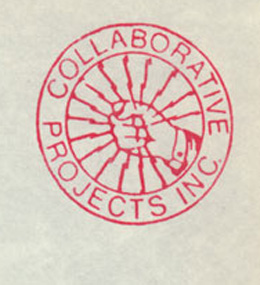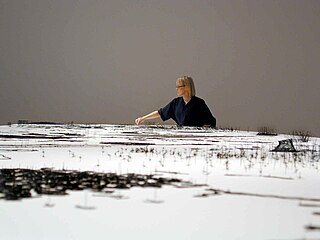Related Research Articles

The Whitney Museum of American Art, known informally as "The Whitney", is a modern and contemporary American art museum located in the Meatpacking District and West Village neighborhoods of Manhattan in New York City. The institution was originally founded in 1930 by Gertrude Vanderbilt Whitney (1875–1942), a prominent American socialite, sculptor, and art patron after whom it is named.

The Museum of Modern Art (MoMA) is an art museum located in Midtown Manhattan, New York City, on 53rd Street between Fifth and Sixth Avenues. The institution was conceived in 1929 by Abby Aldrich Rockefeller, Lillie P. Bliss, and Mary Quinn Sullivan. Initially located in the Heckscher Building on Fifth Avenue, it opened just days after the Wall Street Crash. The museum, America's first devoted exclusively to modern art, was led by A. Conger Goodyear as president and Abby Rockefeller as treasurer, with Alfred H. Barr Jr. as its first director. Under Barr's leadership, the museum's collection rapidly expanded, beginning with an inaugural exhibition of works by European modernists. Despite financial challenges, including opposition from John D. Rockefeller Jr., the museum moved to several temporary locations in its early years, and John D. Rockefeller Jr. eventually donated the land for its permanent site.

The Museum of Contemporary Art (MCA) Chicago is a contemporary art museum near Water Tower Place in the Near North Side of Chicago, Illinois, United States. The museum, which was established in 1967, is one of the world's largest contemporary art venues. The museum's collection is composed of thousands of objects of Post-World War II visual art. The museum is run gallery-style, with individually curated exhibitions throughout the year. Each exhibition may be composed of temporary loans, pieces from their permanent collection, or a combination of the two.
Harrell Fletcher is an American social practice and relational aesthetics artist and professor, living in Portland, Oregon.

The Leather Archives & Museum (LA&M) is a community archives, library, and museum located in the Rogers Park neighborhood of Chicago, Illinois. Founded by Chuck Renslow and Tony DeBlase in 1991, its mission is making “leather, kink, BDSM, and fetish accessible through research, preservation, education and community engagement." Renslow and DeBlase founded the museum in response to the AIDS crisis, during which the leather and fetish communities' history and belongings were frequently lost or intentionally suppressed and discarded.

Colab is the commonly used abbreviation of the New York City artists' group Collaborative Projects, which was formed after a series of open meetings between artists of various disciplines.

The feminist art movement in the United States began in the early 1970s and sought to promote the study, creation, understanding and promotion of women's art. First-generation feminist artists include Judy Chicago, Miriam Schapiro, Suzanne Lacy, Judith Bernstein, Sheila de Bretteville, Mary Beth Edelson, Carolee Schneeman, Rachel Rosenthal, and many other women. They were part of the Feminist art movement in the United States in the early 1970s to develop feminist writing and art. The movement spread quickly through museum protests in both New York and Los Angeles, via an early network called W.E.B. that disseminated news of feminist art activities from 1971 to 1973 in a nationally circulated newsletter, and at conferences such as the West Coast Women's Artists Conference held at California Institute of the Arts and the Conference of Women in the Visual Arts, at the Corcoran School of Art in Washington, D.C..
The Chicago Imagists are a group of representational artists associated with the School of the Art Institute of Chicago who exhibited at the Hyde Park Art Center in the late 1960s.
Nancy Chunn is an American artist based in New York, New York. Known for her commitment to geopolitical issues, Chunn’s work includes a diverse range of paintings.

Irving Kriesberg was an American painter, sculptor, educator, author, and filmmaker, whose work combined elements of Abstract Expressionism with representational human, animal, and humanoid forms. Because Kriesberg blended formalist elements with figurative forms he is often considered to be a Figurative Expressionist.

Anne Wilson is a Chicago-based visual artist. Wilson creates sculpture, drawings, Internet projects, photography, performance, and DVD stop motion animations employing table linens, bed sheets, human hair, lace, thread and wire. Her work extends the traditional processes of fiber art to other media. Wilson is a professor in the Department of Fiber and Material Studies at The School of the Art Institute of Chicago.

Simone Leigh is an American artist from Chicago who works in New York City in the United States. She works in various media including sculpture, installations, video, performance, and social practice. Leigh has described her work as auto-ethnographic, and her interests include African art and vernacular objects, performance, and feminism. Her work is concerned with the marginalization of women of color and reframes their experience as central to society. Leigh has often said that her work is focused on “Black female subjectivity,” with an interest in complex interplays between various strands of history. She was named one of the 100 most influential people in the world by Time magazine in 2023.
Torkwase Dyson is an interdisciplinary artist based in Beacon, New York, United States. Dyson describes the themes of her work as "architecture, infrastructure, environmental justice, and abstract drawing." Her work is informed by her own theory of Black Compositional Thought. This working term considers how spatial networks—paths, throughways, water, architecture, and geographies—are composed by Black bodies as a means of exploring potential networks for Black liberation. She is represented by Pace Gallery and Richard Gray Gallery.
Amanda Williams is a visual artist based in Bridgeport, Chicago. Williams grew up in Chicago's South Side and trained as an architect. Her work investigates color, race, and space while blurring the conventional line between art and architecture. She has taught at the California College of the Arts in San Francisco, Sam Fox School of Design & Visual Arts at Washington University in St. Louis, Illinois Institute of Technology, and her alma mater Cornell University. Williams has lectured at the Metropolitan Museum of Art, New Museum, School of the Art Institute of Chicago, and at a TED conference.

Robert Morris Donley is an American artist who has been identified with the Chicago Imagist movement. Judith Wilson of the Village Voice called him the "Chicago imagist Tolstoy." The narrative aspects of his work center on broad social and political statements that are complex--often playful and satirical with respect to ways in which propaganda, power, and social diversity mix with and conflict with historical and religious personalities. In his career retrospective in 2000 at the Chicago Cultural Center, Dr. Paul Jaskot wrote that "his art investigates the changing political and social geographies of [the modern] city."
Joan Livingstone is an American contemporary artist, educator, curator, and author based in Chicago. She creates sculptural objects, installations, prints, and collages that reference the human body and bodily experience.

Virginia L. Montgomery, also known as VLM, is an American multimedia artist working in video art, sound art, sculpture, performance, and illustration. She has exhibited extensively throughout the U.S. and Europe at museums, galleries, and film festivals. Her artwork is known for its surrealist qualities, material experimentation, and thematic blending of science, mysticism, metaphysics, and 21st century feminist autobiography.

"Untitled" is a work of art by Félix González-Torres, currently in the collection of the Art Institute of Chicago in Chicago, United States. The work is one of the twenty "candy works" in Gonzalez-Torres's oeuvre. The candy works are manifestable; the artworks are not physically permanent, they can exist in more than one place at a time and can vary from one installation to the next in response to the decisions made by the exhibitor, the interactions of audiences, and changing circumstances. This candy work has an ideal weight of 175 pounds (79 kg).
Caroline Kent is an American visual artist based in Chicago, best known for her large scale abstract painting works that explore the interplay between language and translation. Inspired by her own personal experiences and her cultural heritage, Kent creates paintings that explore the power and limitations of communication. Her work, influenced by her Mexican heritage, delves into the potentials and confines of language and reconsiders the modernist canon of abstraction. She likens her composition process to choreography, revealing an interconnectedness between language, abstraction, and painting. Kent's artwork showcases an evolving dialogue of space, matter, and time, resulting in a confluence of drawings, paintings, sculpture, and performance, blurring the lines between these mediums.
The year 2022 in art involves various significant events.
References
- 1 2 3 4 "Abby Zeciroski | Picturing 2020" . Retrieved 2023-06-13.
- 1 2 Luca, Antonio de; Riyait, Jaspal (2020-06-05). "'The World is on Fire:' Artists Respond to the Protests". The New York Times. ISSN 0362-4331 . Retrieved 2023-06-13.
- 1 2 3 4 "ART Local lesbian artist on being banned from social media - Windy City Times News". Windy City Times. 2019-06-26. Retrieved 2023-06-13.
- 1 2 3 GirlTalkHQ (2020-01-08). "Artist Abby Zeciroski Creating Work That Is Unapologetically Pro Choice, Pro LGBTQ+ & Political". GirlTalkHQ. Retrieved 2023-06-13.
- ↑ Xu, Shiyu (2020-06-14). "Artists share virtual support for Black Lives Matter protests". Pavement Pieces. Retrieved 2023-06-13.
- 1 2 "Fletcher Exhibit Catalog 2020". p. 20.
- 1 2 "City Life Org - Bold Feminist Artist Abby Moon Zeciroski". City Life Org. 2022-08-11. Retrieved 2023-06-13.
- 1 2 "These Five Artists Are Confronting the Climate Crisis With Climate Change Art". Green Matters. 2023-04-18. Retrieved 2023-06-13.
- ↑ "Which are the censored artists and artworks on social media that are more mentioned on Google Search?". densitydesign.github.iohttp. Retrieved 2023-06-13.
- 1 2 3 2022 Tenth Anniversary International FL3TCH3R Exhibit awards ceremony: Juror Wesam Mazhar Haddad , retrieved 2023-06-13
- ↑ "Past Exhibitions | Art Museum". Northern Illinois University. Retrieved 2023-06-13.
- ↑ "Poster Finalist". The Star. June 13, 1991. p. 7.
- 1 2 "Works in Progress for Thornwood Show". The Star. May 19, 1991. p. 1.
- ↑ "Juniors, Seniors Recognized During Thornwood Program". The Star. May 23, 1991. p. 12.
- 1 2 "NIU 'Stories From My Childhood' art exhibit opens Nov. 29". Shaw Local. 2022-11-27. Retrieved 2023-06-13.
- 1 2 "North Side". Chicago Gallery News. 2023-06-13. Retrieved 2023-06-14.
- 1 2 Studio, Legacy Designs (2020-06-02). "Black Lives Matter Virtual Art Exhibit 2020". Legacy Designs Studio Inc. Retrieved 2023-06-14.
- ↑ "Sock drive adds to holiday spirit for youth at The Crib - Windy City Times News". Windy City Times. 2016-11-30. Retrieved 2023-06-13.
- ↑ "Thousands at Chicago's 20th annual Dyke March - Windy City Times News". Windy City Times. 2016-06-25. Retrieved 2023-06-13.
- ↑ "Marathon Results of Abby Zeciroski Minton". marathonview.net. Retrieved 2023-06-13.
- ↑ "2012 Monster Dash - Chicago - results for Abby Zeciroski-Minton". Mtec Results. Retrieved 2023-06-13.
- ↑ "Chicago, IL: International Women's Day Exhibition 2024". Tagg Magazine. Retrieved 2024-04-07.
- ↑ "Fletcher Exhibition Catalog 2019". p. 22.